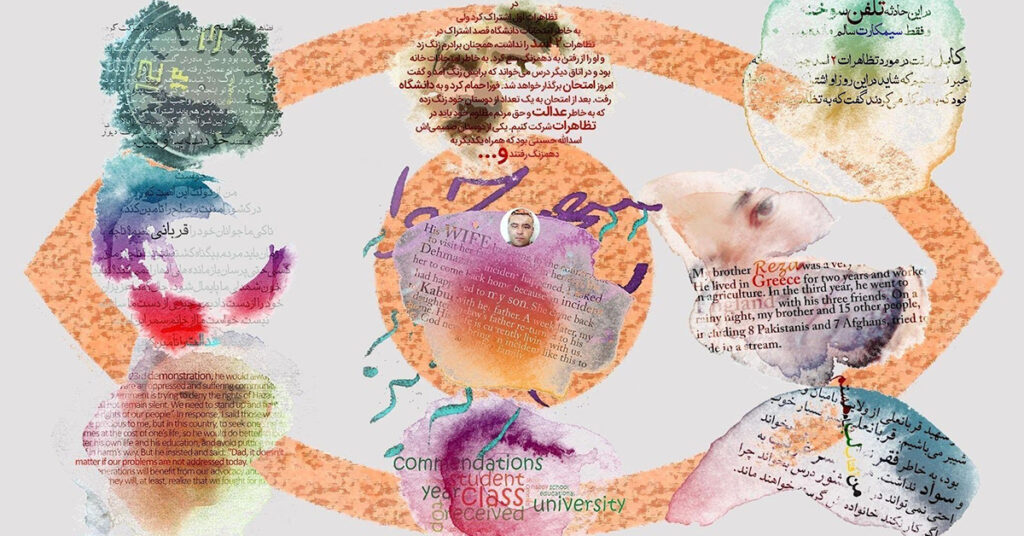Upon entering the Afghanistan Memory Home (AMH) online museum, visitors are confronted by an animated display of eyes, each pair telling its own story and bearing witness to the nation’s complex past. As one navigates through this display, it becomes a stark indication of the sensitive content that lies ahead and sets the stage for the museum’s deeply personal stories.
In a narrative often shaped by external political perspectives, the virtual museum provides a platform for Afghan witnesses and survivors to reclaim their voices, honour their losses and offer a glimpse into the human experiences marred by decades of different regimes, wars and internal conflicts that have shaped the life of Afghan society.
The Afghanistan Human Rights and Democracy Organisation (AHRDO), an NGO committed to promoting human rights, democracy, and justice in Afghanistan, was forced to close its physical museum, located in a basement in Kabul when the Taliban took control of the country in 2021. Exiled in Canada, the organisation focused on establishing a virtual museum to continue honouring and keeping the memories of victims and survivors alive.
“AMH aims to create a safe and inclusive space for victims and survivors to share their experiences, fostering collective memorialisation and providing a comprehensive perspective on the impact of war in Afghanistan. The museum also serves to document and preserve evidence related to the war, contributing to historical understanding and potential truth-telling efforts. Through these objectives, the museum seeks to ensure that the diverse narratives of those affected by the conflict are respectfully recorded and remembered.”
— Afghanistan Human Rights and Democracy Organisation (AHRDO)
From data to stories

AHRDO teamed up with HURIDOCS in 2022 and the organisations embarked on a collective journey to create an online museum using Uwazi as the platform. At the heart of this collaboration lies a commitment to a victim-centred approach where the voices of those who have endured violence steer and guide the narrative.
“By placing victims in control of their own stories, we aim to foster empowerment, authenticity, and a genuine representation of their experiences.”
— Afghanistan Human Rights and Democracy Organisation (AHRDO)
AHRDO’s memorialisation specialist, together with HURIDOCS’ team consisting of documentation experts, developers, and designers, worked closely for an in-depth exploration of the project’s complexity and multiple layers. Through sessions that consisted of project analysis, user research, iterative data modelling, design, and implementation, the team resolved the challenge of transforming AHRDO’s extensive data into more than a simple digital archive and maintaining the memorialisation objective.
Confronted with the formidable task of navigating through the wealth of stories and data preserved by AHRDO over the years, it became pivotal for the team to delve deeply into Afghanistan’s history, while providing a comprehensive picture of the stories.
“Guided by AHRDO, our team approached this challenge with the utmost care, avoiding assumptions and ensuring a respectful understanding. This was key in coming up with a virtual museum that authentically embraced a holistic perspective – not merely to sustain a sense of community among Afghans but also to cultivate a profound understanding for the viewer.”
— HURIDOCS’ Programme Officer, Phurbu Dolma
The outcome is an online museum marked by rich storytelling and thoughtful design, prioritising a victim-centred approach and collective memorialisation. AMH goes beyond the data and focuses on individual stories, creating an atmosphere reminiscent of a “shrine” to honour victims and fostering a sense of community for both local and Afghan diaspora.
Memory boxes and memorialisation
The concept of memorialisation is aimed at remembering and commemorating while honouring those who suffered or died during conflicts. Since 2011, memorialisation has been AHRDO’s mission and is brought to life through the creation of “memory boxes”.
Resembling altars, these memory boxes house a collection of personal items such as photographs, diaries, clothing, and other personal and intimate belongings. They serve as a crucial and poignant entry point to individual stories, capturing the lives of men, women, and children impacted by wars.
Crafted from wood and metal, the memory boxes were initially constructed in 2011 by survivors—family members of war victims—during workshops facilitated by AHRDO. This initiative fostered a sense of community among Afghans, establishing a dedicated space for families and society to collectively mourn and honour the victims. These memory boxes are accompanied by personal narratives and are now accessible in the virtual museum.

Echoing resilience and strength
In a deeply traumatised country, the desire to honour the departed and remember the struggles can be as strong as the impulse to try to suppress painful memories and move forward. For many Afghans, sharing this information means not only a place to remember their loved ones but also to show the world the actual cost of war.
“The Afghanistan Memory Home, in many ways, is my home away from home. It is where I feel my experiences live in, where I have treasured my suffering and my camaraderie with my sister. It is where the stories of thousands of those who have lost loved ones come to life and permanence. The initiative also has a virtual museum, which means not only I can visit it in Canada, but so can many who might feel suffocated under the Taliban.
— Yaser Qubadian, ”In a virtual museum, I treasure my sister’s dreams”
“For now, the Afghanistan Memory Home brings some inner peace to me and many others like me. But I also hope it can eventually contribute to real peace in my country. Maybe not in my generation, but the next one, or the one after. By seeing what their parents and grandparents went through, by understanding how many people we lost in decades of war, they can have a clearer vision of how to create a peaceful Afghanistan.“
“Remembering the past is the only way to see into our future.”

Kawsar Qubadian, Yaser Qubadian’s sister
Memorialising victims in AMH can play a role in the healing process for victims, both deceased and survivors, by offering a platform for their stories and providing validation and acknowledgement. Through the preservation of stories, while respecting and honouring the lives of those being remembered, this project captures the spirit of a society marked by conflicts that continue to aspire to reconciliation and social reconstruction.
“We encourage community participation, particularly from families and survivors, to contribute their stories,” says the team at AHRDO. “In addition to honouring victims and survivors, the museum aims to serve as an educational resource to history and the consequences of war in Afghanistan, but a key aspiration is also to advocate for justice, truth and accountability by preserving evidence related to war.”
It is difficult to estimate the total number of individual stories available in AHRDO’s archives. The virtual museum currently features 600 stories, but it continues to grow as more stories are recorded and added. Some of the stories have been redacted and in some cases, there is information missing due to the volatile nature of the conflict. If you wish to add artefacts or testimonies to AMH, please visit the Contact page. These submissions are carefully and sensitively handled by the dedicated team at AHRDO.
This project was made possible thanks to the support of the International Center for Transitional Justice (ICTJ).
